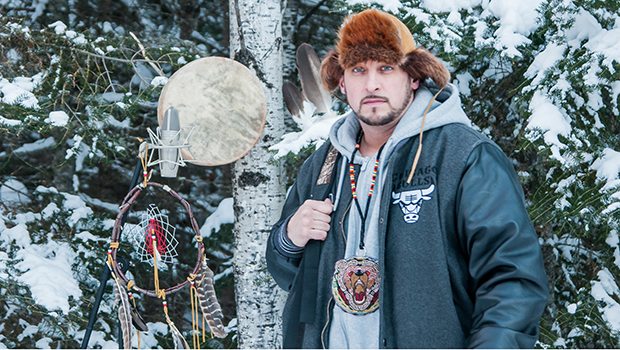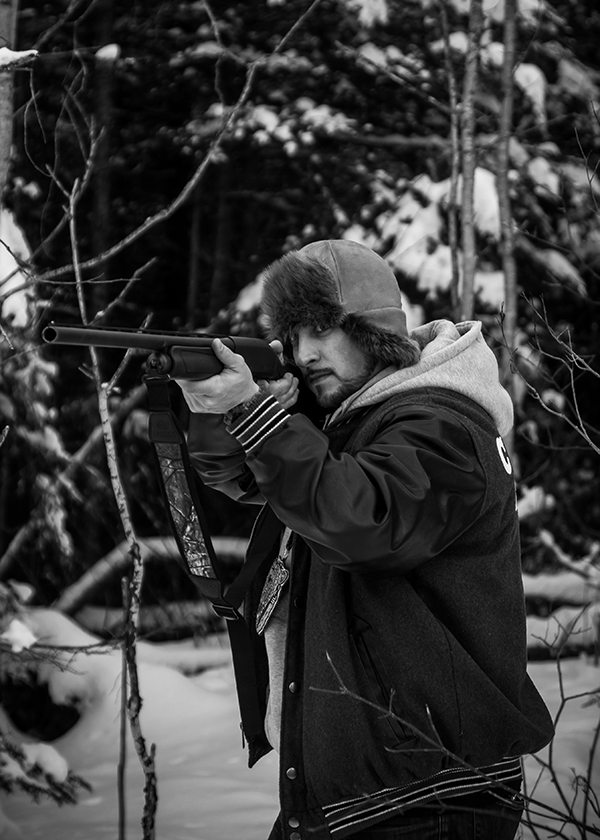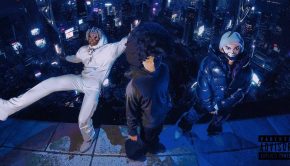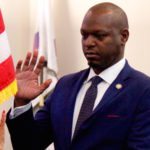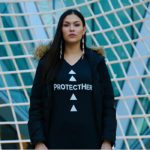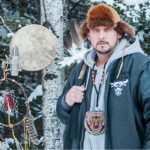Shibastik: In The Seventh Generation
In June 2014, Energy Transfer Partners announced its plans for an oil pipeline route that would threaten the water of the Standing Rock Sioux. This marked the beginning of the #NoDAPL movement, the longest running protest in modern history. As militarized police positioned themselves behind razor wire to confront the nonviolent protestors, the Nation rallied around the Sioux. Thousands of Native and allied supporters traveled to Standing Rock Sacred Stone and Oceti Sakowin camps in North Dakota, to stand in solidarity against the pipeline.
After months of protests, the Army Corp of Engineers were denied easement and were forced to consider rerouting the Dakota Access Pipeline (DAPL). A decision that was quickly overturned by president Trump, whose administration recently revived the controversial Keystone XL pipeline through Canada. But what does this mean for Native America?
DAPL is a $3.8 billion project that would transport crude oil from the Bakken oil fields in North Dakota to Illinois. The pipeline crosses treaty land acquired by the Lakota Nation in 1851 via the treaty of Fort Laramie. It was taken away in the 1950s through eminent domain, so that a series of dams could be built along the Missouri River. Now the Standing Rock Sioux Tribe are subject to the same historical trauma, as the threat of the pipeline could have serious environmental consequences.
The legal basis of the #NoDAPL movement in North Dakota surrounds treaty law. Currently the legality to authorize eminent domain to a private company like Dakota Access or Energy Transfer Partners is under dispute. Despite the easement victory in early December 2016, DAPL continued construction on the pipeline. And on February 8, 2017, the Army Corp of Engineers reversed its pledge to conduct a full environmental impact statement and granted the easement needed to complete the pipeline. In the following week, government officials ordered the Oceti Sakowin camp vacated by February 22.
But the fight is far from over. For Native people, the #NoDAPL movement is more than a land dispute, it is a spiritual campaign that exhibits a collective esteem. A premise that has galvanized into something greater. To protect the earth and everything on it, they must consider how it will affect future generations.
The #NoDAPL movement created a spiritual awakening. It shed light on the traumatic history of the Standing Rock Sioux and other indigenous nations around the world. At the heart of it all, is a group of Native youth known as the International Indigenous Youth Council (IIYC). They focus on developing strong Native identities that center on healing and coping with the effects of intergenerational trauma. Their goal is to empower youth to become leaders in their communities.
Within the spirit of the IIYC, empowerment is a key element to the cause. They have inspired others around the world and have drawn attention to important cultural issues. And there are others like them! Shibastik (Under Ground Flow) is a socially conscious rapper who rhymes about the environment and the importance of preserving his culture. He is a Northern Cree hunter, painter, lyricist, hip-hop artist and a member of the Moose Cree First Nation in Moosonee, Ont. He also carries a message of healing through his traditions, and believes in fighting to protect his culture and identity. Presented with an eagle feather when he was a child, he holds it high today as a reminder of what it means to be a true warrior.
“We need to take to the streets, make a stand and let our voices be heard. But do it all with love, faith and peace in your heart. Smudge and pray daily. And get back out on the land every chance you get. It is healing! … We need our mother earth, and right now she needs us too.” – Shibastik
Today, Shibastik runs a series of workshops. It is the 10-year anniversary of his “Healing Through Hip Hop” and “Hurt People” workshops. His “Healing Through Hip Hop” workshop brakes down into three parts titled ‘Hunt for Healing,’ ‘Native Class,’ and ‘Hurt people’. He also has songwriting, production workshops and art therapy. These workshops focus primarily on a discussion about healing from the intergenerational effects of the residential schools in Canada and connecting with Native culture. Like the IIYC, Shibastik utilizes the principles of the Seventh Generation. He advocates for a generational duty by portraying an empowering message of hope and healing through his work.
With the emergence of the Keystone XL pipeline, Shibastik has a message about the importance of applying pressure in an ongoing spiritual fight while finding inner peace. Using his workshops, he helps the youth share their message through songwriting and artistic expression. The spiritual movement in Standing Rock reminded the world of its duty to Mother Earth. Now on the brink of the #NoDAPL movement, Shibastik points to the treatment of the water protectors, the injustices served and the importance of solidarity during this crucial turning point in the Seventh Generation.
How have you used your art in your community?
My goal with my art has always been to educate or to bring awareness to our issues. Even in my early years as a performer, I would take time in between songs to speak on issues and elaborate on what my music is all about. I’ve spoken at many schools, from elementary schools to universities, as well as conferences and other events. I take advantage of every opportunity to educate my audience. I also have a series of workshops that incorporate my music and artwork with storytelling and motivational/educational speaking. These workshops have brought me across Canada and the United States.
How did you develop your workshops?
I would often be asked to speak with the youth when I was booked to perform in communities across the James Bay region (northern Ontario and Quebec). At first, I spoke about my music, songwriting, my experiences growing up in Moosonee, and moving south for college after high school. Then I started to focus more on my message in music and art, which is keeping our culture alive, protecting the environment, addressing the intergenerational effects of residential schools (depression, addiction, violence, suicide) and creating awareness about the importance of media literacy and corporate influences (media and food). I have been affected by suicide many times throughout my life. It is such a common occurrence in First Nations communities. It has become the norm. So I do what I can to fight that evil.
I think awareness and healing is necessary. I was speaking about these issues at a Suicide Awareness – 7 Teachings Youth Conference that Nishnawbe-Aski Nation (NAN) was hosting in Thunder Bay, Ont. when I was approached by a supervisor at the Kelso Centre. Kelso is a secure custody youth detention center located in Thunder Bay, Ont. The supervisor invited me to come in to the facility to perform and speak to the youth. It went very well, and a few of the youth were already aware of my music. So, I was invited to come in every Sunday to work with the youth and to write and record music with them.
After a couple of weeks, I was hired to work at the facility based on the positive impact I was having on the youth in custody. I was then offered the position of Intensive Rehabilitation in Custody Service Worker, where I would do one to one programming with certain youth. It was at this facility where I would create and develop the Healing Through Hip Hop workshops. I also became a board member on the cultural committee and helped with the facilities cultural programming.
What is your take on the water protectors and the pipeline?
I support them 100 percent. The Dakota Access Pipeline has been extremely disrespectful to say the least. They have crossed many lines. As soon as they found out where the sacred sites were, they sent bulldozers to destroy them, and they brought attack dogs to make sure it happened. Brutal! Soaking people with water in freezing conditions and the use of rubber bullets and stun grenades is not necessary for peaceful protests. It is infuriating, but it shows the strength of the water protectors who stood their ground and remained peaceful. It is inspiring.
I look to the day that we can stop relying on oil. They shouldn’t be building more pipelines. They need to maintain the ones that they have already to prevent any further leaks, and start the process of weening off of fossil fuels. I fear that information is being withheld in the name of profit. I believe in renewable energy. I believe in living in harmony with nature. I don’t think there is any excuse for polluting the environment, especially not financial profit. We should be able to drink the water in the lakes, rivers and creeks. We should be able to gather our own food and medicine without worrying about contamination.
What is the attitude in Canada now that the Keystone XL Pipeline is approved?
I’ve heard talk of people handling the situation in the same way Standing Rock was, peacefully protesting and protecting. I will be a part of it, whether in person or through my art. I plan to make a trip to Standing Rock, to feel that energy and to contribute in any way that I can. I know that fight isn’t over.
My advice is to be true to yourself. Keep it real. Work for a better future in everything you do, but never forget the past. It is a part of you and always will be. Accept it and learn to live with it. Hard times and pain only make you stronger. That is why our people are so strong. We’ve been through so much. The changes that need to be made are systemic. If we want the leadership (whether it’s at the community level, provincial, federal) to enact the changes necessary to ensure equality, healthy food, clean air and water, what we need to do is apply pressure.
We need to take to the streets, make a stand and let our voices be heard. But do it all with love, faith and peace in your heart. Smudge and pray daily. And get back out on the land every chance you get. It is healing! It is rejuvenating! It is where we all come from and it is calling to you! We need our mother earth, and right now she needs us too.
What’s next for you?
What’s next is another album and more workshops! I hope to get to as many reserves and communities as possible. I’ve already been to so many all across Canada as well as in the States, but I’m just getting started! I have a message to share and so do the youth. I use my workshops to share my message, and I help the youth share theirs through songwriting and artistic expression. I also want to point out that I do a lot of work in non-Native schools as well. My message is for everyone!
My music production career began when I started making beats and recording tracks with a small Yamaha keyboard and a double tape deck stereo with a tiny built in mic on top. It took a lot of blank tapes, but I made some original hip hop. There are also my early singles as well as my first album “Wild Game” that I released before Moose River, Wild Life and Underground Flow. I recorded it with Jonathan “Jeex” Garlow on the Six Nations Reserve in 2002/2003. I’ve had it remastered and it will be available on iTunes before the new year. Originality is the biggest thing and what every artist should strive for. I really think that it has been the key to my success. Hard work, originality, and good intentions. The rest falls into place.
Credits:
Written by David Morales
Shibastik: Chris Sutherland
Photographer: Nikki Williams, Nimawi Photography
Tweet

